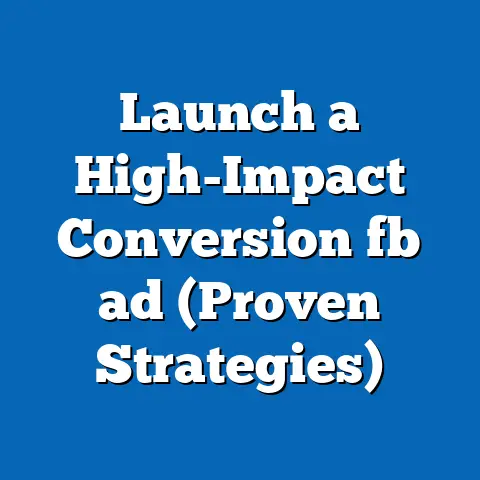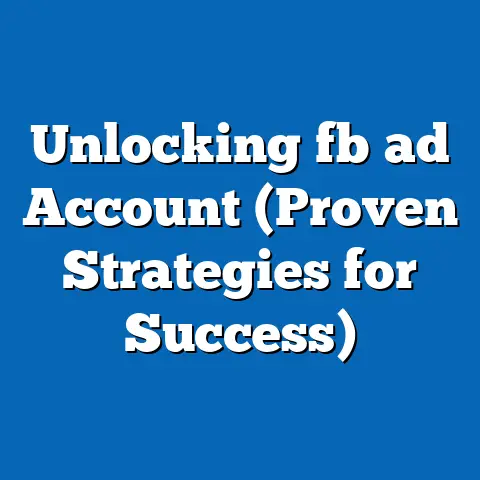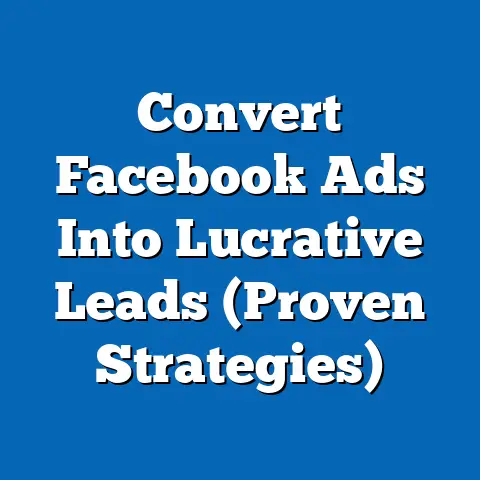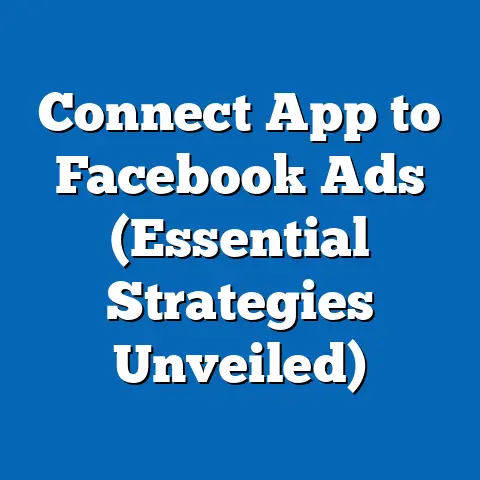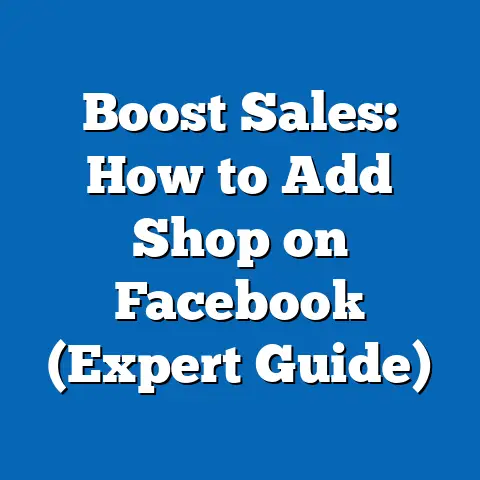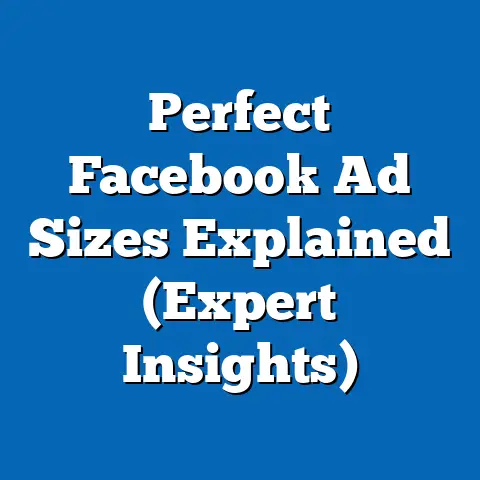Maximize Conversions: Connect Facebook Lead Ads (Pro Strategy)
Imagine Sarah, a passionate baker running a small, local bakery filled with the aroma of freshly baked goods. Sarah poured her heart and soul into creating delectable treats, but despite her efforts, attracting new customers was a constant struggle. Her charming storefront, while inviting, wasn’t enough to compete with the digital noise. One day, while researching new marketing avenues, she stumbled upon Facebook Lead Ads. The promise of efficiently collecting potential customer information piqued her interest. Could this be the solution to connect with her target audience and finally see her business flourish?
This article is about how you, like Sarah, can leverage Facebook Lead Ads to maximize conversions and connect with your target audience effectively. I’ll share the strategies, tips, and insights I’ve gained over years of managing Facebook ad campaigns for businesses of all sizes. From understanding the fundamentals to integrating Lead Ads into your broader marketing strategy, I’ll guide you through the process of turning potential customers into loyal patrons.
Understanding Facebook Lead Ads
Facebook Lead Ads are a game-changer for businesses looking to generate leads directly within the Facebook platform. Unlike traditional ads that redirect users to a landing page, Lead Ads keep users within the familiar Facebook environment, streamlining the process and reducing friction.
What are Facebook Lead Ads?
Lead Ads are specifically designed for mobile devices, recognizing that the majority of Facebook users access the platform on their smartphones. They offer a seamless user experience with pre-filled forms that automatically populate user information from their Facebook profile. This feature significantly reduces the effort required to express interest in a product or service.
For instance, let’s say Sarah wants to promote a new line of gluten-free pastries. With a Lead Ad, users who see the ad can simply tap on it, and a form will pop up with their name, email address, and phone number already filled in. With just a few taps, they can submit their information and express interest in learning more about Sarah’s gluten-free offerings.
Why are Lead Ads Important?
In today’s fast-paced digital world, convenience is king. Lead Ads capitalize on this by making it incredibly easy for users to express interest without leaving the Facebook app. This is a significant advantage over traditional ads that require users to click through to a website, navigate to a form, and manually enter their information.
Lead Ads are important because:
- Reduced Friction: The pre-filled forms minimize the effort required to submit information.
- Mobile-Friendly: Designed specifically for mobile devices, ensuring a seamless experience for the majority of Facebook users.
- Direct Lead Generation: Allows you to collect leads directly within the Facebook platform, eliminating the need for a separate landing page.
- Increased Conversion Rates: By simplifying the process, Lead Ads often result in higher conversion rates compared to traditional ads.
The Power of Lead Ads: Statistics and Case Studies
The effectiveness of Facebook Lead Ads is backed by numerous success stories and industry statistics. Facebook themselves have published case studies showcasing the impressive results achieved by businesses using Lead Ads.
For example, a study by Facebook revealed that Lead Ads can generate leads at a cost that is significantly lower than traditional methods. In one case, a car dealership used Lead Ads to generate leads at a cost that was 4x lower than their previous lead generation efforts.
Another example is a real estate company that used Lead Ads to collect information from potential homebuyers. By targeting users with specific interests and demographics, they were able to generate a high volume of qualified leads at a fraction of the cost of traditional advertising.
Takeaway: Facebook Lead Ads offer a powerful way to generate leads directly within the Facebook platform. Their mobile-friendly design and pre-filled forms make it easy for users to express interest, leading to higher conversion rates and lower costs.
Creating Compelling Lead Ads
Creating a high-converting Lead Ad requires careful attention to several key components. From crafting compelling headlines to selecting engaging visuals, every element plays a crucial role in capturing the attention of your target audience and encouraging them to submit their information.
Key Components of a High-Converting Lead Ad
A successful Lead Ad typically consists of the following elements:
- Compelling Headline: The headline is the first thing users see, so it needs to be attention-grabbing and relevant to their interests.
- Engaging Visual: The visual (image or video) should be visually appealing and relevant to the product or service being offered.
- Persuasive Ad Copy: The ad copy should clearly communicate the value proposition and encourage users to take action.
- Targeted Audience: The ad should be shown to users who are most likely to be interested in the product or service being offered.
- Effective Lead Form: The lead form should be short, user-friendly, and collect only the essential information needed to qualify leads.
Targeting the Right Audience
Facebook’s robust targeting options are one of the platform’s greatest strengths. You can target users based on a wide range of criteria, including:
- Demographics: Age, gender, location, education, job title, etc.
- Interests: Hobbies, activities, pages they like, etc.
- Behaviors: Purchase history, device usage, travel habits, etc.
- Custom Audiences: Upload your own customer lists or create audiences based on website visitors or app users.
- Lookalike Audiences: Create audiences that are similar to your existing customers.
For Sarah’s bakery, she could target users in her local area who have expressed an interest in baking, desserts, or gluten-free options. She could also create a custom audience based on her existing customer list and then create a lookalike audience to reach new potential customers who share similar characteristics.
Designing an Effective Lead Form
The lead form is where the magic happens. It’s your opportunity to collect the information you need to qualify leads and follow up with them effectively. However, it’s important to strike a balance between gathering enough information and keeping the form short and user-friendly.
Here are some tips for designing an effective lead form:
- Keep it Short: Only ask for the essential information you need. The more fields you add, the lower your conversion rate will be.
- Use Pre-Filled Fields: Take advantage of Facebook’s pre-filled fields to minimize the effort required to submit the form.
- Clearly State Your Value Proposition: Remind users of the benefits they will receive by submitting their information.
- Include a Privacy Policy: Be transparent about how you will use their information.
- Use Conditional Logic: If you need to ask more detailed questions, use conditional logic to show or hide fields based on the user’s previous responses.
For example, Sarah’s lead form could ask for the user’s name, email address, and their favorite type of pastry. She could also include a checkbox asking if they are interested in receiving special offers and promotions.
Learning from Successful Lead Ads
One of the best ways to improve your Lead Ads is to study successful examples from other businesses. Pay attention to their headlines, visuals, ad copy, and lead forms. What makes them effective? What can you learn from their approach?
Here are a few examples of successful Lead Ads:
- Fitness Studio: A fitness studio might use a Lead Ad to offer a free trial class to local residents. Their headline could be “Try Our Fitness Studio FREE for 7 Days!” Their visual could be an image of people enjoying a workout class. Their ad copy could highlight the benefits of joining their studio, such as improved fitness, weight loss, and increased energy.
- Software Company: A software company might use a Lead Ad to offer a free demo of their product to potential customers. Their headline could be “Get a FREE Demo of Our Powerful Software!” Their visual could be a video showcasing the software’s features. Their ad copy could highlight the benefits of using their software, such as increased productivity, reduced costs, and improved efficiency.
- Travel Agency: A travel agency might use a Lead Ad to offer a free travel consultation to potential travelers. Their headline could be “Plan Your Dream Vacation with a FREE Consultation!” Their visual could be an image of a beautiful travel destination. Their ad copy could highlight the benefits of working with their travel agency, such as expert advice, personalized service, and exclusive deals.
Takeaway: Creating compelling Lead Ads requires careful attention to several key components, including compelling headlines, engaging visuals, persuasive ad copy, targeted audiences, and effective lead forms. Studying successful examples from other businesses can provide valuable inspiration and insights.
Integrating Lead Ads with Your Marketing Strategy
Facebook Lead Ads are not a standalone solution. To maximize their effectiveness, it’s essential to integrate them seamlessly with your broader marketing strategy. This includes connecting Lead Ads with other marketing efforts, such as email marketing and CRM systems, and developing effective follow-up strategies.
Connecting Lead Ads with Other Marketing Efforts
One of the most powerful ways to integrate Lead Ads with your marketing strategy is to connect them with your email marketing platform. This allows you to automatically add new leads to your email list and send them targeted messages based on their interests and demographics.
Many popular email marketing platforms, such as Mailchimp, Constant Contact, and AWeber, offer direct integrations with Facebook Lead Ads. This means that whenever someone submits a lead form, their information is automatically transferred to your email list, triggering a welcome sequence or other automated email campaigns.
You can also connect Lead Ads with your CRM system, such as Salesforce or HubSpot. This allows you to track leads throughout the sales process and gain valuable insights into their behavior and preferences.
Developing Effective Follow-Up Strategies
Generating leads is only the first step. To turn those leads into customers, you need to develop effective follow-up strategies. This includes:
- Timely Email Responses: Send a welcome email immediately after someone submits a lead form. Thank them for their interest and provide them with the information they requested.
- Personalized Content: Segment your email list based on the information collected in the lead form and send them personalized content that is relevant to their interests.
- Targeted Offers: Offer exclusive deals and promotions to leads who have expressed a strong interest in your product or service.
- Phone Calls: If appropriate, follow up with leads by phone to answer their questions and provide them with additional information.
For Sarah’s bakery, she could send a welcome email to new leads offering a discount on their first purchase. She could also segment her email list based on the type of pastry they are interested in and send them personalized recipes and baking tips.
Using Data to Refine Customer Personas
The data you collect from Lead Ads can be a goldmine of information about your target audience. By analyzing this data, you can refine your customer personas and gain a deeper understanding of their needs, interests, and preferences.
This information can be used to improve your targeting, ad copy, and lead forms, leading to higher conversion rates and lower costs.
For example, if Sarah notices that a large percentage of her leads are interested in vegan pastries, she could create a new ad campaign specifically targeting vegan customers. She could also develop new vegan pastry recipes and promote them to this audience.
Takeaway: Integrating Lead Ads with your broader marketing strategy is essential for maximizing their effectiveness. This includes connecting Lead Ads with other marketing efforts, such as email marketing and CRM systems, and developing effective follow-up strategies. The data you collect from Lead Ads can be used to refine your customer personas and improve your overall marketing performance.
Analyzing and Optimizing Performance
Measuring the success of your Facebook Lead Ads campaigns is crucial for identifying what’s working and what’s not. By tracking key performance indicators (KPIs) and using A/B testing, you can continuously optimize your campaigns for maximum performance.
Measuring Key Performance Indicators (KPIs)
Key Performance Indicators (KPIs) are measurable values that demonstrate how effectively you are achieving your business objectives. When it comes to Facebook Lead Ads, some of the most important KPIs to track include:
- Click-Through Rate (CTR): The percentage of users who click on your ad after seeing it. A high CTR indicates that your ad is relevant and engaging to your target audience.
- Conversion Rate: The percentage of users who submit a lead form after clicking on your ad. A high conversion rate indicates that your lead form is effective and user-friendly.
- Cost Per Lead (CPL): The average cost of generating a lead. A low CPL indicates that your campaign is efficient and cost-effective.
- Lead Quality: The quality of the leads you are generating. Are they qualified prospects who are likely to become customers?
The Power of A/B Testing
A/B testing, also known as split testing, is a method of comparing two versions of an ad to see which one performs better. By testing different headlines, visuals, ad copy, and lead forms, you can identify the elements that resonate most with your target audience and improve your campaign performance.
For example, Sarah could A/B test two different headlines for her Lead Ad:
- Headline A: “Get a FREE Pastry with Your First Order!”
- Headline B: “Indulge in Delicious, Homemade Pastries Today!”
By running both ads simultaneously and tracking their performance, Sarah can determine which headline generates more leads.
Using Facebook Ads Manager for Analysis
Facebook Ads Manager provides a wealth of data and insights that can help you analyze and optimize your Lead Ads campaigns. You can use Ads Manager to track your KPIs, A/B test different ad elements, and gain a deeper understanding of your target audience.
Some of the key features of Ads Manager include:
- Real-Time Reporting: Track your campaign performance in real-time.
- Customizable Dashboards: Create custom dashboards to track the KPIs that are most important to you.
- Audience Insights: Gain insights into the demographics, interests, and behaviors of your target audience.
- A/B Testing Tools: Easily create and manage A/B tests.
Takeaway: Analyzing and optimizing your Facebook Lead Ads campaigns is crucial for maximizing their performance. By tracking key performance indicators (KPIs), using A/B testing, and leveraging the power of Facebook Ads Manager, you can continuously improve your campaigns and generate more high-quality leads.
Conclusion
Remember Sarah, the baker who was struggling to attract new customers? By implementing the strategies discussed in this article, she successfully maximized her conversions through Facebook Lead Ads. She crafted compelling ads, targeted the right audience, developed effective follow-up strategies, and continuously optimized her campaigns based on data-driven decisions.
You, too, can harness the power of Facebook Lead Ads to connect with your audience and drive growth. With the right approach, businesses of all sizes can benefit from this powerful lead generation tool.
So, take action, experiment with your own Lead Ads, and embrace the opportunities that come with effective digital marketing. Your next customer is just a click away!
Call to Action:
Subscribe to my newsletter for more insights on digital marketing strategies and stay updated with the latest trends. Share your own experiences with Facebook Lead Ads in the comments section below. I’d love to hear your success stories!

